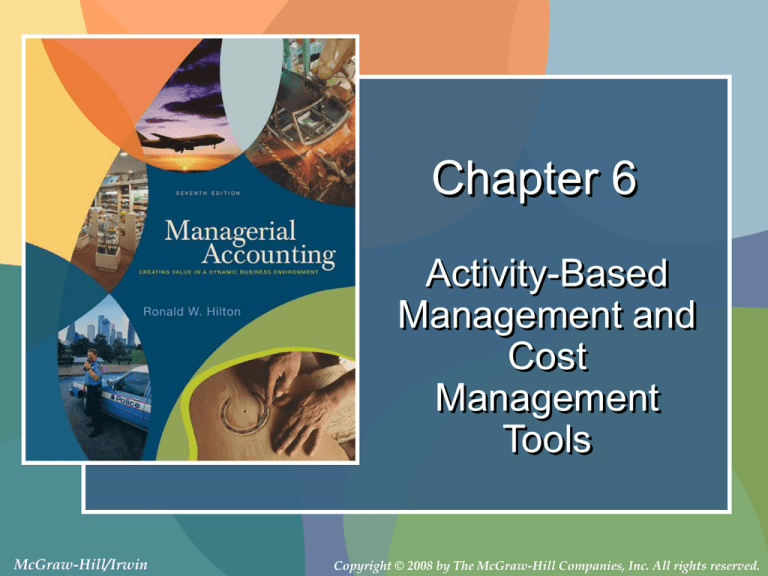
Chapter 6
Activity-Based
Management and
Cost
Management
Tools
McGraw-Hill/Irwin
Copyright © 2008 by The McGraw-Hill Companies, Inc. All rights reserved.
Learning
Objective
1
McGraw-Hill/Irwin
Copyright © 2008 by The McGraw-Hill Companies, Inc. All rights reserved.
Activity-Based Management
The use of
ABC costing
information
to help
management
make decisions
Activity-Based Management
Activity-based costing establishes relationships
between overhead costs and activities so that
we can better allocate overhead costs.
Activity-based management focuses
on managing activities to reduce costs.
Learning
Objective
2
McGraw-Hill/Irwin
Copyright © 2008 by The McGraw-Hill Companies, Inc. All rights reserved.
Two-Dimensional ABC and ActivityBased Management
Activities
Two-Dimensional ABC and ActivityBased Management
Cost Assignment View
Resource costs
Activities
Cost Objects
Two-Dimensional ABC and ActivityBased Management
Cost Assignment View
Resource costs
Process View
Activity Analysis
Root
Causes
Activity
Triggers
Activity Evaluation
Activities
Cost Objects
Performance
Measures
Learning
Objective
3
McGraw-Hill/Irwin
Copyright © 2008 by The McGraw-Hill Companies, Inc. All rights reserved.
Elimination of Non-Value-Added
Costs
Activities
Nonvalueadded
activities
Unnecessary
Necessar
y
Reduce or
Eliminate
Continually Evaluate
and Improve
Using ABM to Eliminate Non-ValueAdded Activities and Costs
Identify Activities.
Using ABM to Eliminate Non-ValueAdded Activities and Costs
Identify Activities.
Identify Nonvalue-Added Activities.
Using ABM to Eliminate Non-ValueAdded Activities and Costs
Identify Activities.
Identify Non-Value-Added Activities.
Understand Activity Linkages, Root Causes,
and Triggers.
Specify
parts
Select
vendor
Receive
parts
Produce
goods
Inspect
finished
goods
Rework
defective
products
Using ABM to Eliminate Non-ValueAdded Activities and Costs
Identify Activities.
Identify Non-Value-Added Activities.
Understand Activity Linkages, Root Causes,
and Triggers.
Specify
parts
Select
vendor
Receive
parts
Produce
goods
Inspect
finished
goods
Establish Performance Measures.
Rework
defective
products
Using ABM to Eliminate Non-ValueAdded Activities and Costs
Identify Activities.
Identify Non-Value-Added Activities.
Understand Activity Linkages, Root Causes,
and Triggers.
Specify
parts
Select
vendor
Receive
parts
Produce
goods
Inspect
finished
goods
Establish Performance Measures.
Report Non-Value-Added Costs.
Rework
defective
products
Using ABM to Eliminate Non-ValueAdded Activities and Costs
Process time
Inspection time
Move time
Storage time
Waiting time
Achieving Cost Reduction
Activity
Reduction
Activity
Selection
Reduce
Non-Value-Added
Costs
Activity
Sharing
Activity
Elimination
Learning
Objective
4
McGraw-Hill/Irwin
Copyright © 2008 by The McGraw-Hill Companies, Inc. All rights reserved.
Customer Profitability Analysis
Customer profitability analysis uses
activity-based costing to determine
the activities, costs, and profit associated
with serving particular customers.
Customer Profitability Analysis
Required
special
packaging.
Orders
small
quantities.
Demand
fast
service.
Often
changes
orders.
Orders
frequently.
A costly customer
Customer Profitability Analysis
Customer-Related Activities
Order processing
Sales contacts (phone calls, faxes, etc.)
Sales visits
Shipment processing
Billing and collection
Design/engineering change orders
Special packaging
Special handling
Cost Driver Base
Purchase orders
Contacts
Visits
Shipments
Invoices
Design changes
Units packaged
Units handled
A company may use these customer
related costs to help determine the
profitability of each customer.
Cost Drive
Rate
$
150
100
1,000
200
160
4,000
40
60
Customer Profitability Analysis
Cumulative Operating Income as a % of Total
Operating Income
Customer Profitability
125.0%
100.0%
75.0%
50.0%
25.0%
75% of actual operating income
50% of actual operating income
25% of actual operating income
0.0%
1
2
3
4 5
6
7
8 9 10 11 12 13 14 15 16 17 18 19 20
Learning
Objective
5
McGraw-Hill/Irwin
Copyright © 2008 by The McGraw-Hill Companies, Inc. All rights reserved.
Target Costing
Design a product, and the manufacturing
process, so that the product can be
manufactured at a cost that will enable the firm
to make a profit when the product is sold at an
estimated market-driven price.
Target
Price
Target
Cost
Target
Profit
Target Costing
Value engineering is used to achieve a
product design that meets the target cost.
Quality of
materials
Number of
parts
Change
component
s
Change
methods
Learning
Objective
6
McGraw-Hill/Irwin
Copyright © 2008 by The McGraw-Hill Companies, Inc. All rights reserved.
Kaizen Costing
The process of cost reduction during the
manufacturing phase of an existing product
Product cost
Current year
cost base.
.
3/31/x1
.
3/31/x2
Cost base for
next year.
Kaizen Costing
Kaizen cost goal is established to help
achieve continuous cost reduction.
Product cost
.
3/31/x1
}
.
3/31/x2
Kaizen goal
cost-reduction
amount.
Learning
Objective
7
McGraw-Hill/Irwin
Copyright © 2008 by The McGraw-Hill Companies, Inc. All rights reserved.
Benchmarking
The continual
search for the
most effective
method of
accomplishing a
task, by
comparing
existing methods
and performance
levels with those
of other
organizations.
Here are
the best
practices
in our
industry. . .
Re-engineering
The complete redesign of a process, with an
emphasis on finding creative new ways to
accomplish an objective.
Theory of Constraints
A management approach seeking to maximize
long-run profit through proper management
of organizational bottlenecks or constrained
resources.
Learning
Objective
8
McGraw-Hill/Irwin
Copyright © 2008 by The McGraw-Hill Companies, Inc. All rights reserved.
Just-in-Time Inventory and
Production Management
No materials are purchased and no products
are manufactured until they are needed.
The primary goal of a
JIT production system is
to reduce or eliminate
inventories at every
stage of production.
Key Features of the JIT Approach
Smooth, uniform production rate
Pull method of production
Purchase is small lot sizes
Quick, inexpensive setups
High quality materials
Effective preventive maintenance
Teamwork
Multiskilled workers
JIT Purchasing
Long-term
contracts with
suppliers.
Only a few
suppliers.
Parts delivered
in small lots.
Grouped
payments to
vendor.
Minimal
inspection of
materials.
Learning
Objective
9
McGraw-Hill/Irwin
Copyright © 2008 by The McGraw-Hill Companies, Inc. All rights reserved.
Activity-Based Management in the
Service Industry
Customer
Profitability
Analysis
Activity
Analysis
End of Chapter 6
Now this is an
activity that I
can manage!





